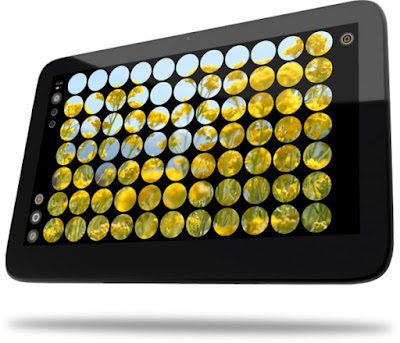ExoPC Slate

It's nearly a year since Steve Ballmer stood on stage at CES and waved a hand at a bench full of slate format tablet devices running Windows 7. That's a year in which very few Windows tablet devices have actually shipped, and one where Android and iOS have taken the tablet crown away from Microsoft. The received wisdom is that Windows is just too bulky for a tablet, making them slow and unwieldy. So it's a pleasant surprise to get our hands on a tablet that's designed to run Windows – and run it well.
The ExoPC Slate is a widescreen device, with an 11.6" 1366 x 768 capacitive multi-touch screen. The device is light, coming in at just under a kilo at 950g, and small enough to slip into a bag, measuring just 295 x 195 x 14.0mm. The capacitive screen has two pressure-sensitive touch points, allowing limited touch typing on the on-screen keyboard and basic gaming. You might prefer to use a capacitive pen, especially if you're writing on screen, but for most purposes finger touch is perfectly adequate.
It's probably best to compare the ExoPC's performance to a high-end netbook, as it's built around an Intel Atom processor (a Pineview-M N450) with Intel's own GMA 3150 graphics and a Broadcom Crystal HD accelerator for HD video. 2GB of RAM helps with Windows performance, and our test device came with 32GB SSD, with 64GB devices also available. Connectivity is wireless only, with 802.11 b/g/n WiFi and Bluetooth, though 3G is promised for future devices. There's not much expansion capability, but as this is a slate you're not likely to want to plug in Express Cards. There are two USB ports if you want to connect a USB 3G modem or synchronise a smartphone, and a SD card reader for working with a camera. There's also an HDMI out port with 1080P video, ready for connection to a wide screen TV.
Output and input ports on the side of the ExoPC
Raw Windows 7 isn't the best touch user interface out there. It works well enough, but there are still UI elements that harken back to XP and before, and they're just not finger-friendly. There is one touch-friendly Windows UI on the ExoPC – Windows Media Center. It turns out that its large scale pan-and-slide UI works really well on a touch device, and it's not surprising that its Metro design language became the basis of Windows Phone 7. It's just a pity that it's only for playing and exploring media files.
Using Media Center on the ExoPC
That's why ExoPC has developed its own user interface layer, where applications and web sites are displayed as a grid of circular icons that take you straight to where you want to go. It's an application in its own right, so you can minimise or close it if you want to use Windows. When you use the launcher, some applications, like the BBC iPlayer are framed by the ExoPC UI, while others launch outside, in the familiar Windows 7 view. There's an online store for Flash and Silverlight applications, which have to packaged using ExoPC's free ExoFactory tool. You can quickly add Windows applications to the launch screen from ExoPC's own file manager. Just tap on an .EXE, and use the arrow-shaped icon to add your chosen application. You can also add applications to the UI by editing the underlying XML file, but we wouldn’t really recommend that approach unless you're adding a custom icon.
There are some nice touches in the ExoPC UI, like the ability to close an application from the task bar by sliding it off to the right, but it's really just an application launcher. Yes, there's the opportunity to use Flash and Silverlight widgets, but there's not much else in the UI layer. That's only a minor criticism though, as like the iPad, this is a device for content consumption and a simple touch-based launcher is all you really need if you're trying to catch up with Top Gear on iPlayer. If you want to browse the web, ExoPC provides its own browser, although it's really just a skin on top of Internet Explorer.
Like the iPad, the ExoPC has a sealed battery. That saves on weight and space, but it does mean that you can't switch between batteries when you're on the road. That can be a problem, as while the ExoPC has better battery life than many netbooks, it's still around half that of an ARM-based tablet, clocking in at around five hours. At least the reported battery life on the Windows battery meter is accurate, so you won't be left suddenly wondering where all your power went! The power supply is small and light, so you won't be carrying around too much extra weight – but it's something else to think about (and something else to lose).
This is the closest we've seen yet to an iPad competitor, out-performing many of the Android devices we've tried. Pricing's also good, with our test device coming in at £429 (ExoPC aims to match iPad pricing and storage). However it is 10% bigger, 25% heavier and half the battery life of an iPad, and you'll need to take that into account before making any purchasing decisions. There are still issues with the user interface, but regular updates add new features (we gained an on-screen volume control during our tests). If you want a Windows tablet now, then this is the device for you – just remember that what you're getting is a high end netbook, not a full-blown Windows PC.
Simon Bisson
